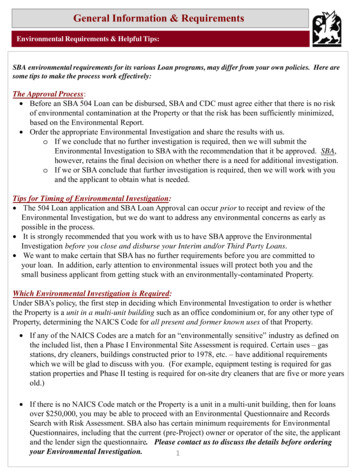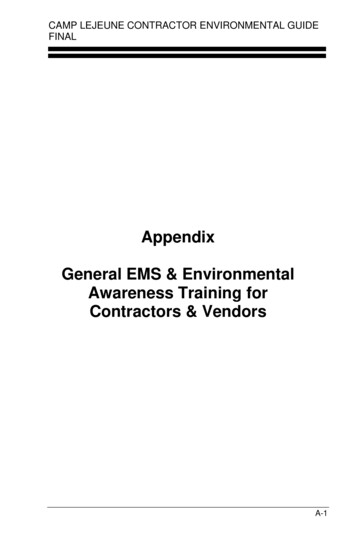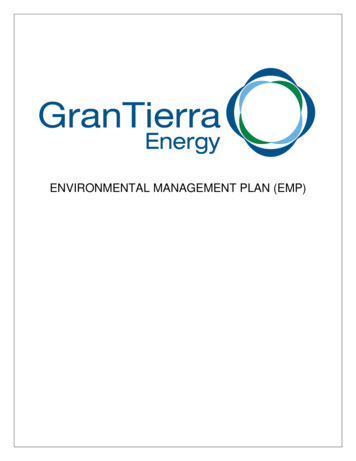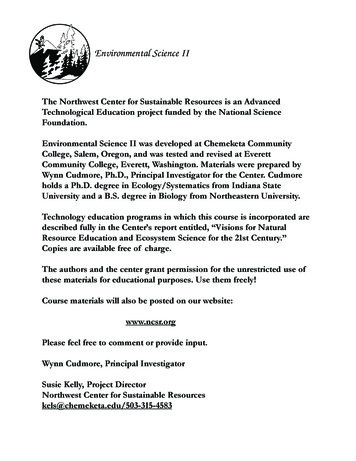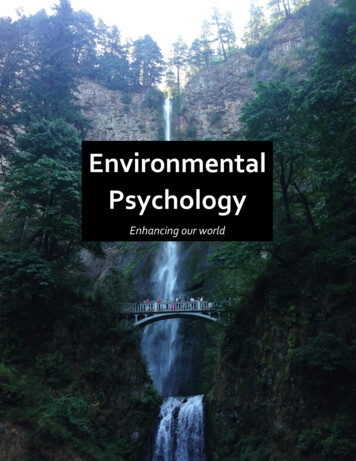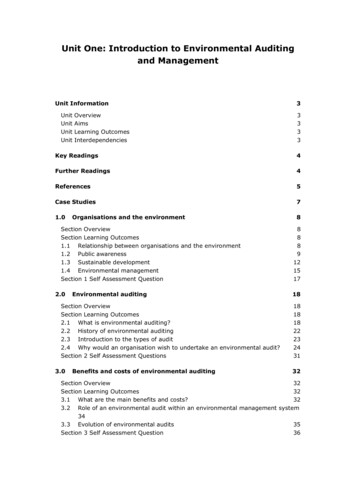
Transcription
Unit One: Introduction to Environmental Auditingand ManagementUnit InformationUnitUnitUnitUnitOverviewAimsLearning OutcomesInterdependencies33333Key Readings4Further Readings4References5Case Studies71.08Organisations and the environmentSection OverviewSection Learning Outcomes1.1 Relationship between organisations and the environment1.2 Public awareness1.3 Sustainable development1.4 Environmental managementSection 1 Self Assessment Question2.0Environmental auditingSection OverviewSection Learning Outcomes2.1 What is environmental auditing?2.2 History of environmental auditing2.3 Introduction to the types of audit2.4 Why would an organisation wish to undertake an environmental audit?Section 2 Self Assessment Questions3.0Benefits and costs of environmental auditing8889121517181818182223243132Section Overview32Section Learning Outcomes323.1 What are the main benefits and costs?323.2 Role of an environmental audit within an environmental management system343.3 Evolution of environmental audits35Section 3 Self Assessment Question36
P508Environmental Auditing and Environmental Management SystemsUnit 1Unit Summary37Unit Self Assessment Question37Key Terms and Concepts38 SOASCeDEP2
P508Environmental Auditing and Environmental Management SystemsUnit 1UNIT INFORMATIONUnit OverviewThis unit provides an introduction to the subject of environmental auditing andmanagement. It starts by making you aware of the concepts on which environmentalauditing is based. These include introducing the relationship between organisationsand the environment within which they operate, and the problems this can cause;public awareness; sustainable development; and environmental management. Theunit then goes on to define environmental auditing and introduces the key wordsassociated with the subject. A brief history of environmental auditing is alsoprovided. The last part of this unit looks at the main reasons why organisationsundertake environmental audits. Each of the reasons is discussed in turn, and theobjectives and benefits of environmental auditing are analysed. The unit alsointroduces the concept of environmental management systems (EMSs) and howauditing fits within them.Unit Aims To introduce the subject of environmental auditing and management. To provide an awareness of the concepts on which environmental auditing isbased.Unit Learning OutcomesBy the end of this unit, students should be able to: recognise the relationship between organisations and the environment explain what environmental auditing is and how it originated describe the benefits of environmental auditing and how it fits with the widerenvironmental management responsibilities of an organisation assess critically the benefits of environmental auditingUnit InterdependenciesThis unit links to Unit 2 which provides more detail on the types of audit and on thelegislation relevant to companies.Case studies on the Construction Sector; the Hospitality Sector; the Electrical andElectronic Sector SOASCeDEP3
P508Environmental Auditing and Environmental Management SystemsUnit 1KEY READINGSSection 1 Brady J (2011) The response of organizations. In: Brady J, Ebbage A, Lunn R(eds) Environmental Management in Organizations: The IEMA Handbook, 2ndedn. Earthscan, London, pp. 251–260.This is the main supporting text for the module — Chapter 3.1 in particular, providesbackground to this unit.Section 2 Gensburg LJ, Pantea C, Fitzgerald E, Stark A, Hwang S-A, Kim N (2009) Mortalityamong former Love Canal residents. Environmental Health Perspectives 117(2)209–216.This article provides background information on a key case in the US that promptedenvironmental liability legislation.FURTHER READINGSDEAT (2004) Environmental Auditing. Integrated Environmental ManagementInformation Series No 14, Department of Environmental Affairs and Tourism (DEAT).Pretoria.Available files/docs/series14 environmental auditing.pdfHumphrey N, Hadley M (2000) Environmental Auditing. Palladian Law Publishing Ltd,Bembridge, Isle of Wight. SOASCeDEP4
P508Environmental Auditing and Environmental Management SystemsUnit 1REFERENCESBBC News online (Wednesday 18 July 2007) Cement Firm‟s Pollution Fine Cut.Available from:http://news.bbc.co.uk/1/hi/england/coventry warwickshire/6904850.stm[Accessed 26 March 2013]Crump A (1991) Dictionary of Environment and Development: People, Places, Ideasand Organisations. Earthscan, London.Dagg S (2005) C108 Environmental Auditing. Module prepared for the DistanceLearning Programme, Imperial College London.Gensburg LJ, Pantea C, Fitzgerald E, Stark A, Hwang S-A, Kim N (2009) Mortalityamong former Love Canal residents. Environmental Health Perspectives 117(2)209–216.Humphrey N, Hadley M (2000) Environmental Auditing. Palladian Law Publishing Ltd,Bembridge, Isle of Wight.Hunt D, Johnson C (1995) Environmental Management Systems. McGraw Hill,London.International Chamber of Commerce (1989) Environmental Auditing. June 1989, ICCPublication No 468, International Chamber of Commerce (ICC), Paris.International Chamber of Commerce (1991) ICC Guide to Effective EnvironmentalAuditing. ICC Publication No 483, International Chamber of Commerce (ICC), Paris.Meadows DH, Meadows DL, Randers J, Behrens III WW (1972) The Limits to Growth.Universe Books, New York.Smets H (1988) The cost of accidental pollution. Industry and Environment 11(4)28–33.Thetimes100 (2010) Business Objectives, Planning and Stakeholders.Available from: ss-objectivesplanning-stakeholders--321.php [Accessed 26 March 2013]UN (2002) World Summit on Sustainable Development (WSSD). Johannesburg 26August to 4 September 2002, United Nations (UN).Available from: http://www.un.org/events/wssd/ [Accessed 26 March 2013] SOASCeDEP5
P508Environmental Auditing and Environmental Management SystemsUnit 1UN/DESA (2003) Johannesburg Declaration on Sustainable Development – from ourOrigins to the Future. United Nations Department of Economic and Social Affairs(UN/DESA).Available from: radoc 116827.pdf[Accessed 26 March 2013]UNESCAP (2005) Environmental sustainability under threat. In: State of theEnvironment in Asia and the Pacific, United Nations Economic and Social Commissionfor Asia and the Pacific (UNESCAP), pp. 17–130.Available from: inpub/[Accessed 26 March 2013]UNESCAP pment.ESCAPvirtualAvailable wareness/sustainable development/sd definition.htm [Accessed 26 March 2013].United Nations (1992) Agenda 21. Earth Summit. The United Nation‟s Programme ofAction from Rio. Division for Sustainable Development, United Nations Departmentof Economic and Social AffairsAvailable documents/Agenda21.pdf[Accessed 23 April 2013]WCED (1987) Our Common Future. World Commission on Environment andDevelopment (WCED), Oxford Paperbacks.Wikipedia (undated) List of Environmental Disasters.Available from: http://en.wikipedia.org/wiki/List of environmental disasters[Accessed 26 March 2013]Wikiquote (undated) Albert Einstein. WikiquoteAvailable from: http://en.wikiquote.org/wiki/Albert Einstein[Accessed 26 March 2013] SOASCeDEP6
P508Environmental Auditing and Environmental Management SystemsUnit 1CASE STUDIESCase Study 1 Construction Sector.Section 1.1 provides an illustration of the benefits a company might gain from environmentalauditing.Case Study 2 Electrical and Electronic SectorSection 2.1 provides an illustration of the ways in which this sector interacts with theenvironment.Case Study 3 Hospitality SectorSection 3.1 provides an illustration of the ways in which this sector interacts with theenvironment. SOASCeDEP7
P508Environmental Auditing and Environmental Management SystemsUnit 11.0 ORGANISATIONS AND THE ENVIRONMENTSection OverviewTo provide an understanding of the relationship between organisations and theenvironment and the pressures and effects each has on the other.Section Learning OutcomesBy the end of this section, students should be able to: recognise the effects of an organisation on the environment and vice versa identify the different pressures on organisations to improve their environmentalperformance1.1Relationship between organisations and theenvironmentTo understand the development of the concept of environmental auditing, we firstneed to look in more detail at the relationship between organisations and theenvironment within which they operate. First of all we will examine this at themacro-scale, that is, in terms of global developments in environmental thinking,and then we will look at how this has affected individual organisations at the microscale, that is, local level.How should we view the relationship between organisations and the environment?The relationship is two-way, with each having the ability to affect the other.Organisations affect the environment in many ways. There are direct effects, forexample accidental spillage of oil from the refinery may cause pollution of a watercourse local air quality may decrease due to emissions released from the oil refinery‟sstack water and energy consumptionThere are also indirect effects, for example the environmental impact of the finished product petrol or plastics traffic generated by employees of the oil refinery may contribute to pollution onlocal roads waste produced after the end of the product‟s life environmental taxes such as the Landfill Tax and the Climate Change Levy inthe United Kingdom (UK) have an impact on the cost structure of companies.Even though they are not direct environmental effects, they are environmentrelated economic effects designed to reduce the environmental impact of anorganisationThe environment affects organisations in many ways, such as climatic changes and its relationship to fossil fuel use laws aimed at protecting the environment (eg those governing air pollution)may place constraints upon an industry and require capital outlay for newequipment SOASCeDEP8
P508Environmental Auditing and Environmental Management SystemsUnit 1Historically, environmental problems have often been created or exacerbated bybusiness and industry. Pollution of rivers and watercourses by sewage generatedwithin urban conurbations has long been a problem, and growth inchlorofluorocarbon (CFC) pollution, the presence of dioxins in the food chain, and theburden of hazardous wastes are all evidence of the rapid rate at which industry hasdeveloped and the manner in which this has happened. The world‟s first nationalpublic pollution control agency, the Alkali Inspectorate, was established in Britain in1863 to control atmospheric emissions, primarily from the caustic soda industry.Most countries in the world now have substantial (and ever-increasing) amounts ofenvironmental legislation, which aim to control the effects of organisations on theenvironment. At the European level, there is also the European Environment Agency(EEA), which aims to improve the quality of the environment in Europe throughsupporting national policies and monitoring and reporting on harmonised standardsand regulations EU-wide. The United Nations Environment Programme (UNEP) and itsvarious programmes, especially the Industry and Environment Programme in Paris,perform a similar, but global, role. 1.2Read the Key Reading from Environmental Management inOrganizations: The IEMA Handbook by Brady (2005) and then look atthe Introduction sections for the following two case studies: theElectrical and Electronic Sector case study (CS2) and the HospitalitySector case study (CS3) which summarise some of the key interactionsbetween these types of organisations and the environment.Public awarenessMore recently, public pressure over environmental issues has created a new set ofconstraints acting upon industrial production. It is difficult for industry to deny itsrole in damaging the environment or to refute the need for environmental protection.Growing public concern over environmental issues means that decision makers canno longer assume that the public will continue to tolerate continuing environmentalexploitation and degradation. Public concern over activities which were damaging theenvironment led to the establishment of several „environmental‟ groups in the late19th century – the first British environmental group was the „Commons, OpenSpaces and Footpaths Preservation Society‟, in 1865. Others soon followed, forexample, the Sierra Club in the United States of America (USA) began in 1892, andmost of the groups were concerned with protecting open spaces and buildings ofhistoric interest for public enjoyment.The growth in public awareness of environmental issues was therefore largelywestern-led. The publication in the early 1960s of Silent Spring by American authorRachel Carson is widely regarded as the watershed of public opinion. This bookdetailed for the first time the impact of chemicals, particularly those used inagriculture, on the environment and human health. The major events of the 1970swere the two oil crises, where actions by the Organization of the Petroleum ExportingCountries (OPEC) caused oil prices to triple during 1973–1974, and again between1978 and 1980. This brought a realisation of just how dependent industrial societieswere on fossil fuel energy, and generated a huge growth in environmentalawareness. The environmental implications of resource use were also highlighted inthe influential Limits to Growth Report of the Club of Rome (Meadows et al 1972), SOASCeDEP9
P508Environmental Auditing and Environmental Management SystemsUnit 1which coincided with the 1973 oil crisis. Environmental pressure groups began toincrease in popularity, and „Green‟ political parties began to gain votes.The series of high-profile incidents involving industry during the 1980s once againincreased the public‟s awareness of environmental issues and brought theenvironment to the top of the political agenda worldwide. Disasters such as those atBhopal and Chernobyl undermined public confidence in certain sectors of industryand forced the activities of industry and the subsequent damaging consequences forthe environment into the spotlight. Further details on the two incidents mentionedabove are presented in 1.2.1 and 1.2.2.1.2.1 Bhopal high-profile industrial incidentsBhopal was one of the world‟s worst human-created disasters. In 1984, thousands ofpeople died as a result of a leak of deadly methyl-isocyanate gas at the Union Carbidefactory in Bhopal, India. Exact figures are impossible to obtain, as the bodies of manyvictims were cremated, and others died later, having left the area. Four years after theaccident, the Indian government estimated that at least one person per day in the areassurrounding the factory died as a result of injuries or illness caused by the leak, and thedeath toll was reported to exceed 3150. Unofficial figures suggest that as many as500 000 could be injured, disabled or physically or mentally disturbed as a result of theaccident. Diseases of the eyes and gastrointestinal tract were commonplace. Followinglengthy battles, the Indian government and Union Carbide finally agreed on a 470 million settlement of all civil and criminal proceedings arising from the disaster,although Union Carbide denied liability. The Indian government originally claimed 3 billion, far less than would have been claimed if the victims had been Americans. Itsattempts to have the case heard in the American courts failed, Union Carbide claimingthat the leak was caused deliberately by a disgruntled employee. The national and localgovernments in India are claiming a total of 67 million in expenses, which means thatthe 500 000 Bhopal residents who are finally expected to seek compensation are likely toreceive less than 1000 each.Source: adapted from Crump (1991) p. 32.1.2.2 Chernobyl high-profile industrial incidentsChernobyl is a nuclear power station in the former USSR, which, in 1986, suffered theworld‟s worst nuclear disaster. The accident, which occurred as a result of anexperiment involving the switching off of safety systems in one of the four reactors,caused the deaths of 31 people. At least 129 others suffered acute radiation sickness,and many thousands are expected to die prematurely as a consequence of exposure toradiation released from the stricken plant. Costs of the disaster exceeded 350 billion.Clean-up and reparation costs included encasing the ruptured reactor in steel andconcrete, the evacuation of 116 000 people from the immediate vicinity of the powerstation, compensation for the loss of property and crops, and the costs of long-termmedical treatment for those suffering the effects of radiation sickness. Radiationreleased into the atmosphere from Chernobyl drifted across much of Europe, andrestrictions placed on the consumption of meat and vegetables for fear that they mightbe contaminated were still in place in 1990 in countries as far away as the UK. Estimatessuggest that a minimum of 2000 people in the European Community are likely to developcancers over the next 50 years as a result of this radioactive fallout. The reactorcomplex was finally shut down completely in December 2000, following years ofdiplomatic pressure from the EU towards the (now Ukrainian) government who argued itneeded the electricity regardless. The structure that initially contained the radiation —the hastily erected sarcophagus — is crumbling and urgent repairs are needed, for whichvery little money is available.Source: adapted from Crump (1991) p. 49. SOASCeDEP10
P508Environmental Auditing and Environmental Management SystemsUnit 1All of the companies involved in these incidents were large corporations, and wereaware of many environmental issues relating to their organisations. In all cases poorplanning, lack of contingency planning, and little awareness of the impact ofcatastrophic failures upon the local environment resulted in disasters, which causedsevere damage to the environment and human health. Can you think of any events/incidents involving business and industry inyour country, which highlight the damage done to the environment?Identify and provide a summary of an event/incident in your country.You may also want to include information on:– how you think these events influenced public opinion and attitudestowards environmental issues– what, if any, response was made by the government of your countryWikipedia provides a long list of examples of environmental disasters – have a lookthe website (Wikipedia undated) – but just a few examples include: 1950 1960 Mercury poisoning at Minamata, Japan 1952 London smog kills 4000 1957 Fire at Windscale nuclear reactor, UK, causes radioactive releases 1967 Torrey Canyon oil tanker disaster off the Scilly Isles, UK 1979 Near-meltdown at Three Mile Island nuclear power station, USA 1984 Accident kills over 2000 at Union Carbide plant, Bhopal, India 1984 Liquefied natural gas explosion kills 452 in Mexico City 1986 Chernobyl nuclear power station disaster 1986 Sandoz warehouse fire, Basel, pollutes Rhine 1989 Exxon Valdez tanker accident, Alaska 1990 Shell fined 1 million for oil pollution of river Mersey, UK 1998 Reservoir of toxic mine waste broke and spilled its contents into theGuadiamar River, Spain 2006 Southeast Asian haze event caused by continued uncontrolled burningfrom „slash and burn‟ cultivation in Indonesia 2010 BP Deepwater Horizon oil rig explosion and spill, Gulf of MexicoAs a result of some of these incidents, inquiries have led to subsequent changes inprocedures, such as the introduction of new legislation, or additional provision foremergencies. As the 1980s proceeded, increasing public concern over environmentalissues began to manifest itself through the changing habits of consumers. Thephenomenon of green consumerism emerged as a more environmentally awarepublic demanded goods and products which minimised environmental damage. Inline with the general increase of public awareness of environmental issues, the rise of„green consumerism‟ also began in the West. SOASCeDEP11
P508Environmental Auditing and Environmental Management Systems Unit 1What are your perceptions of green consumerism? Write down at leastsix key points.Political recognitionThe growing awareness of environmental issues was reflected politically in the firstUnited Nations (UN) conference on the Human Environment in Stockholm in 1972,and the subsequent creation of the United Nations Environment Programme (UNEP).For many, the Stockholm conference established the legitimacy of environmentalismas a political movement and provided the first major recognition of the significance ofenvironmental issues. Prior to September 1988, no serving national leader of globalimportance had made a major address on the environment, but 1988/89 broughtstatements of concern from Mrs Thatcher (UK), President Bush (USA), PresidentGorbachev (USSR), Chancellor Kohl (Germany), President Mitterand (France),European Commission President Jacques Delors, and many other heads of state.„Environmental issues‟ began to appear in the manifestos of all the major politicalparties in the West, as politicians realised that their stance on the environment was acontributing factor in their success or otherwise in winning votes.1.3Sustainable development„The world we have created as a result of our thinking thus far hasproblems which cannot be solved by thinking the way that we thoughtwhen we created them.‟Source: attributed to Albert Einstein (Wikiquote undated)The industrialised world has already used up many of the Earth‟s naturalresources, and we are now realising that it will not be possible to carry on in thesame way if we want to protect the future of our planet and those who live on it.However, it seems that with increasing technological abilities, we are better able toextract known, or find new, reserves. In addition, reductions in the material intensityof products the amount of material needed to produce a product has graduallydeclined. But, in many cases, the availability of resources should not mean that wedo not have a problem with using that resource. For example, even though we seemto have „enough‟ lead, the health and environmental effects of lead use still make astrong case against its persistent or increased use. Equally with fossil fuels: if wecompare the carbon emissions that come from using fossil fuels (gas, coal, and oil) mainly in the combustion engine and power stations and which contribute to thegreenhouse effect and climate change, then we are much more likely to exceedacceptable levels of atmospheric pollution before we run out of fossil fuels.Ultimately, all economic development depends on the Earth‟s natural resource base.Concern over the rate at which the Earth‟s resources are being used has led to thedevelopment of the concept of „sustainable development‟, a term that you willprobably be familiar with. The most widely used definition of sustainabledevelopment, and one which you should remember, is that given by the WorldCommission on Environment and Development (WCED) in its milestone report OurCommon Future (otherwise known as the Brundtland Report) in 1987 (WCED 1987).This is much quoted in defining sustainable development, but usually only the firstpart is quoted and not the second part, which is a critical qualifier to the first: SOASCeDEP12
P508Environmental Auditing and Environmental Management SystemsUnit 1„Sustainable development is development that meets the needs of thepresent without compromising the ability of future generations to meettheir own needs. It contains within it two key concepts:–The concept of “needs”, in particular the essential needs of the world‟spoor, to which overriding priority should be given; and– The idea of limitations imposed by the state of technology and socialorganisation on the environment‟s ability to meet present and futureneeds.‟Source: WCED (1987) p. 43.There are also several clarifying definitions, for example,The United Nationsdevelopment evelopment which improves people‟s quality of life, within the carryingcapacity of earth‟s life support systems‟Source: UNESCAP (undated)The World Conservation Union (IUCN) provides the following description ofsustainable development:„The guiding rules are that people must share with each other and carefor the Earth. Humanity must take no more from nature than nature canreplenish. This in turn means adopting lifestyles and development pathsthat respect and work within nature's limits. It can be done withoutrejecting the many benefits that modern technology has brought.Provided that technology also works within those limits.‟Source: UNESCAP (undated)It is clear that to enable society to develop in a sustainable manner, an approachother than that which has previously been employed is required. Sustainabledevelopment will present the greatest challenge in the wealthiest nations, whichconsume the most resources, release the most pollution, and have the greatestcapacity to make the necessary changes. However, leaders in some developingcountries are suspicious of the concept, as they fear that the industrialised countrieswill dictate the development path that the developing countries must take; that is,the developing countries fear they will be penalised for the previous mistakes of thedeveloped world.Sustainable development requires a profound change in the goals and assumptionsthat drive corporate activities and changes in daily practices and tools. In otherwords, we need to develop an entirely new attitude towards environmentalresponsibilities. Business and industry have a vital role to play in determining thefuture of the planet and in working towards achieving sustainable development. Thisis recognised in the WCED report. SOASCeDEP13
P508Environmental Auditing and Environmental Management SystemsUnit 1„Many essential human needs can be met only through goods andservices provided by industry . It has the power to enhance or degradethe environment; it invariably does both.‟Source: WCED (1987) p. 182.For business, the concept of sustainable development presents a challenge – toproduce higher levels of output while using lower levels of input and generating lesswaste. Organisations are now faced with the challenge of integrating environmentalconsiderations into all aspects of their business, and environmental auditing is oneof a number of environmental management tools, which enable them to do this.The Earth SummitIn 1992, 176 governments sent delegates to the UN Conference on Environment andDevelopment in Rio – known as the „Earth Summit‟. The Rio conference reinforcedthe importance of increased emphasis on environmental issues in every sector of theeconomy. Agenda 21 (UN 1992), the global plan of action, which was adopted atthe Earth Summit, contains a chapter on the role of business and industry in securingsustainable development. Agenda 21 states that businesses should participate in awide range of environmental management tasks, of which environmental auditing isone.You have seen how worldwide developments in environmental consciousness haveled to major changes in the way in which governments, investors, and thecommunity at large perceive the importance of the environment. At the level of theindividual organisation, these developments have meant tighter legislative controls constraints on the use of natural resources increasing pressure from customers and suppliers greater employee and management interest in the way the organisationapproaches its environmental responsibilitiesThese factors have prompted organisations to seek new ways of integratingenvironmental considerations into all aspects of their business. In some cases thishas been a requirement of regulatory bodies, while in other cases, a more proactiveapproach is taken and organisations voluntarily investigate ways of improving theirenvironmental performance.Between 26 August and 4 September 2002 the UN held a follow-up conference to the1992 Earth Summit. This was the World Summit on Sustainable Development(WSSD) (UN 2002) and was held in Johannesburg, South Africa. The conference wasset up to ratify, reinforce, and provide for stronger implementation of the manyinternational agreements and conventions relating to environment and development.One of the key outcomes from the Summit included a range of commitments andtargets aimed at achieving more effective implementation of sustainabledevelopment objectives (UN/DESA 2003). SOASCeDEP14
P508Environmental Auditing and Environmental Management Systems1.4Unit 1Environmental managementSo far this unit has described the growth of environmental awareness by the public,and the increasing importance awarded to the subject by politicians. Pressure on anorganisation to improve its environmental performance comes from many sources,both internal and external to the organisation.There is a wide range of parties potentially that have an interest in a company andtherefore that also have an interest in the effect of a company‟s practices on theenvironment. These are often referred to as „stakeholders‟ – people or groups ofpeople who have an interest, a stake, in an organisation. This „stakeholder concept‟of business contrasts with the more traditional „shareholder concept‟, which aims tomaximise wealth for shareholders (investors in the company). These different modelsof business will inevitably result in different business objectives (and business plansfor delivering those objectives) since those objectives will seek to balance therequirements of different stakeholders (under the former model) rather than justmaximise benefit to shareholders (in the latter). Consequently, there will be multiple
accidental spillage of oil from the refinery may cause pollution of a watercourse local air quality may decrease due to emissions released from the oil refinery‟s stack water and energy consumption There are also indirect effects, for example the environm


